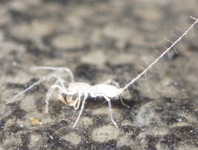Abstract
A new species of marine free living nematode Spinonema gracilispiculum sp. n. is described from the oxygen minimum zone of the eastern Arabian Sea (216m) margin. This new nematode species was found exclusively in the station with sandy texture and dissolved oxygen level 0.35 ml/l and are represented by only few individuals from a single location, despite analysing 288 core samples from an extensive survey along the eastern Arabian Sea OMZ region covering from 06°57′19″N to 21°30′639″N. Spinonema gracilispiculum sp. n. differs from other known species of the genus in the body length, position of the dorsal spine, contour and span of lateral alae, size and shape of spicules, number of pre cloacal setae and sexual dimorphism in presence of dorsal spine and amphideal fovea shape. This is the first record of the genus Spinonema from the Indian Ocean. A pictorial and dichotomous keys to the species of Spinonema are also provided, supplemented with comparative morphometric details of all valid species based on published information.
References
Bezerra, T.N., Decraemer, W., Eisendle-Flöckner, U., Hodda, M., Holovachov, O., Leduc, D., Miljutin, D., Mokievsky, V., Peña Santiago, R., Sharma, J., Smol, N., Tchesunov, A., Venekey, V., Zhao, Z. & Vanreusel, A. (2019) Nemys: World Database of Nematodes. Spinonema Larrazábal-Filho, Neres, Da Silva & Esteves, 2019. Available from: http://www.nemys.ugent.be/aphia.php?p=taxdetails&id=1350316/ (accessed 20 April 2020)
Cobb, N.A. (1933) New nemic genera and species, with taxonomic notes. Journal of Parasitology, 20, 81–94.
https://doi.org/10.2307/3272166
Daday, E.V. (1899) Uj-guineai szabadon élö nematodok. Mathematikai és természettudo- mányi Értesitö, 17, 557–572.
De Coninck, L.A. (1965) Classe des Nématodes—Systématique des Nématodes et sous-classe des Adenophorea. Traité de Zoologie, 4, 586–681.
Decraemer, W. & Hunt, D.J. (2006) Structure and classification. In: Perry, R.N. & Moens, M. (Eds.), Plant Nematology. Vol. 1. CAB International, Wallingford, pp. 3–32.
https://doi.org/10.1079/9781845930561.0003
Diaz, R.J. & Rosenberg, R. (1995) Marine benthic hypoxia, a review of its ecological effects and the behavioural responses of benthic macrofauna. Marine Biology Annual Review, 33, 245–303.
El-Wakeel S.K. & Riley, J.P. (1957) The determination of organic carbon in marine muds. Journal of Du Counseil International Exploration, 22, 180–3.
https://doi.org/10.1093/icesjms/22.2.180
Larrazabal-Filho, A.L., Neres, P.A., Da Silva, M.C. & Esteves, A.M. (2019) A new genus with three new species of free-living marine nematodes of the subfamily Desmodorinae (Nematoda: Desmodoridae), from the continental shelf off northeastern Brazil. Zootaxa, 4615 (2), 321–342.
https://doi.org/10.11646/zootaxa.4615.2.5
Filipjev, I.N. (1922) New data about free-living nematodes of the Black Sea. Transactions of Stavropol Agricultural Institute, 1, 83–184.
Gooday, A.J., Bett, B.J., Escobar, E., Ingole, B., Levin, L.A., Neira, C., Raman, A.V. & Sellanes, J. (2010) Biodiversity and habitat heterogeneity in oxygen minimum zones. Marine Ecology, 31, 125–147.
https://doi.org/10.1111/j.1439-0485.2009.00348.x
Gourgault, N. & Decraemer, W. (1986) Nematodes marins de Guadeloupe III. Epsilonematidae des genres nouvaeaux Metaglochinema n. g. (Glochinematinae) et Keratonema n. g. (Keratonematinae n. subfam). Bulletin du Muséum national d’histoire naturelle, Paris, 4e Series, 8, Section A, 1, 171–183.
Helly, J.J. & Levin, L.A. (2004) Global distribution of naturally occurring marine hypoxia on continental margins. Deep Sea Research Part I, 51, 1159–1168.
https://doi.org/10.1016/j.dsr.2004.03.009
Hunter, W.R., Oguri, K., Kitazato, H., Ansari, Z.A. & Witte, U. (2011) Epi-benthic megafaunal zonation across an oxygen minimum zone at the Indian continental margin. Deep Sea Research Part I, 58, 699–710.
https://doi.org/10.1016/j.dsr.2011.04.004
Levin, L.A., Huggett, C.L. & Wishner, K.F. (1991) Control of deep-sea benthic community structure by oxygen and organic-matter gradients in the eastern Pacific Ocean. Journal of Marine Research, 49, 763–800.
https://doi.org/10.1357/002224091784995756
Levin, L.A., Gage, J.D., Martin, C. & Lamont, P.A. (2000) Macrobenthic community struc- ture within and beneath the oxygen mini- mum zone, NW Arabian Sea. Deep Sea Research Part II, 47, 189–226.
https://doi.org/10.1016/S0967-0645(99)00103-4
Lorenzen, S. (1974) Glochinema nov. gen (Nematodes: Epsilonematidae) aus Sudchile. Mikrof d Meeresbod, 47, 393–412.
Micoletzky, H. (1924) Letzter bericht über freilebende nematoden aus Suez. Sitzungsberichte der Akademie der Wissenschaften in Wien, Mathematischen-Naturwissenschaft Klasse, 133, 137–179.
Platt, H.M. & Warwick, R.M. (1988) Free-living Marine Nematodes. Part II. British Chromadorids. Leiden, Brill, 502 pp.
Rosenberg, R., Arntz ,W.E., Chuman de Flores, E., Flores, L.A., Carbajal, G., Finger, I. & Tarazona, J. (1983) Benthos biomass and oxygen deficiency in the Peruvian upwelling system. Journal of Marine Research, 41, 263–279.
https://doi.org/10.1357/002224083788520153
Sanders, H.L. (1969) Benthic marine diversity and the stability-time hypothesis. In: Diversity and Stability in Ecological Systems, In: Woodwell, G.M. & Smith, H.H. (Eds.), Brookhaven National Laboratory, Upton, New York, pp. 71–81.
https://doi.org/10.1163/187529259X00381
Seinhorst, J.W. (1959) A rapid method for the transfer of nematodes from fixative to anhydrous glycerin. Nematologica, 4, 67–69.
https://doi.org/10.1163/187529259X00381
Soetaert, K. & Heip, C. (1995) Nematode assemblages of deep sea and shelf break sites in the North Atlantic and Mediterranean Sea. Marine Ecological Progress Series, 125, 171–183.
https://doi.org/10.3354/meps125171
Tchesunov, A.V. (2014) 7.13 Order Desmodorida De Conink, 1965. In: Schmidt-Rhaesa A. (Eds.), Handbook of Zoology. Gastrotricha, Cycloneuralia, Gnathifera. Vol. 2. Nematoda. de Gruyter, Berlin, pp. 399–434.
Tyson, R.V. & Pearson, T.H. (1991) Modern and ancient continental shelf anoxia. Vol. 58. Geological Society of London Special Publication. Geological Society of London, London, 24 pp.
https://doi.org/10.1144/GSL.SP.1991.058.01.01
Vanaverbeke, J., Bezerra, T.N., Braeckman, U., De Groote, A., De Meester, N., Deprez, T., Derycke, S., Guilini, K., Hauquier, F., Lins, L., Maria, T., Moens, T., Pape, E., Smol, N., Taheri, M., Van Campenhout, J., Vanreusel, A., Wu, X. & Vincx, M. (2014) NeMys: World Database of Free-Living Marine Nematodes. Available from: https://nemys.ugent.be/ (accesed on 11 November 2014)
Verschelde, D & Vincx, M (1995) Psammonema gen. n. and Pseudochromadora Daday, 1889 (Nematoda, Desmodoridae) from sandy sediments of Gazi, Kenya. Bulletin van het Koninklijk Belgisch Instituut voor Natuurwetenschappen, Biologie, 65, 11–39.
Verschelde, D., Gourbault, N. & Vincx, M. (1998) Revision of Desmodora with descriptions of new desmodorids (Nematoda) from hydrothermal vents of the Pacific. Journal of Marine Biological Association UK, 78, 75 –112.
https://doi.org/10.1017/S0025315400039977
Verschelde, D., Nicholas, W. & Vincx, M. (2006) A review of the genera Croconema Cobb, 1920 and Pseudochromadora Daday, 1899 (Nematoda, Desmodoroidea): new species from the coasts of Kenya and Australia. Hydrobiologia, 571, 17–40.
https://doi.org/10.1007/s10750-006-0194-0


